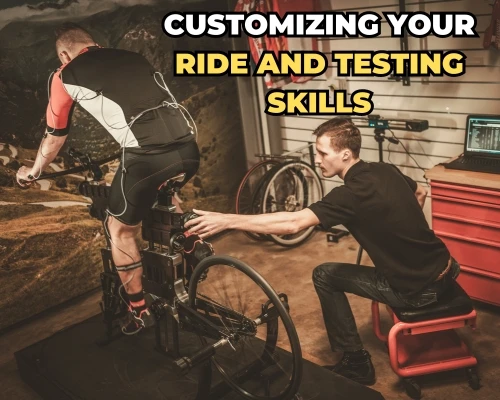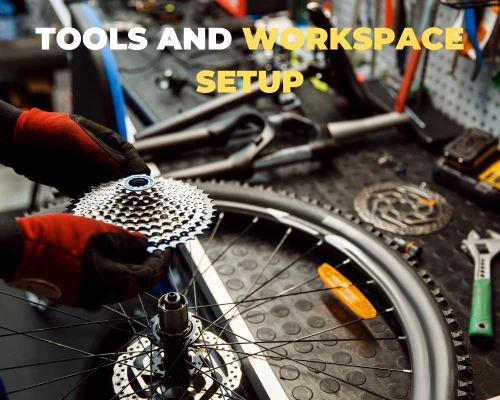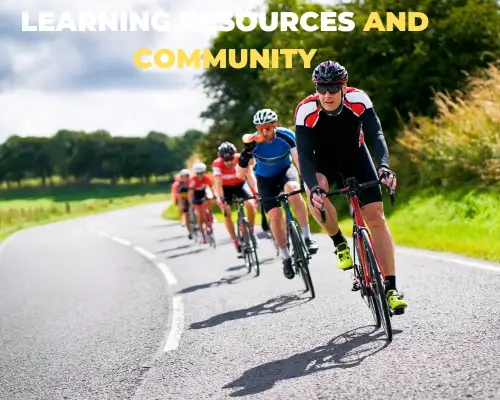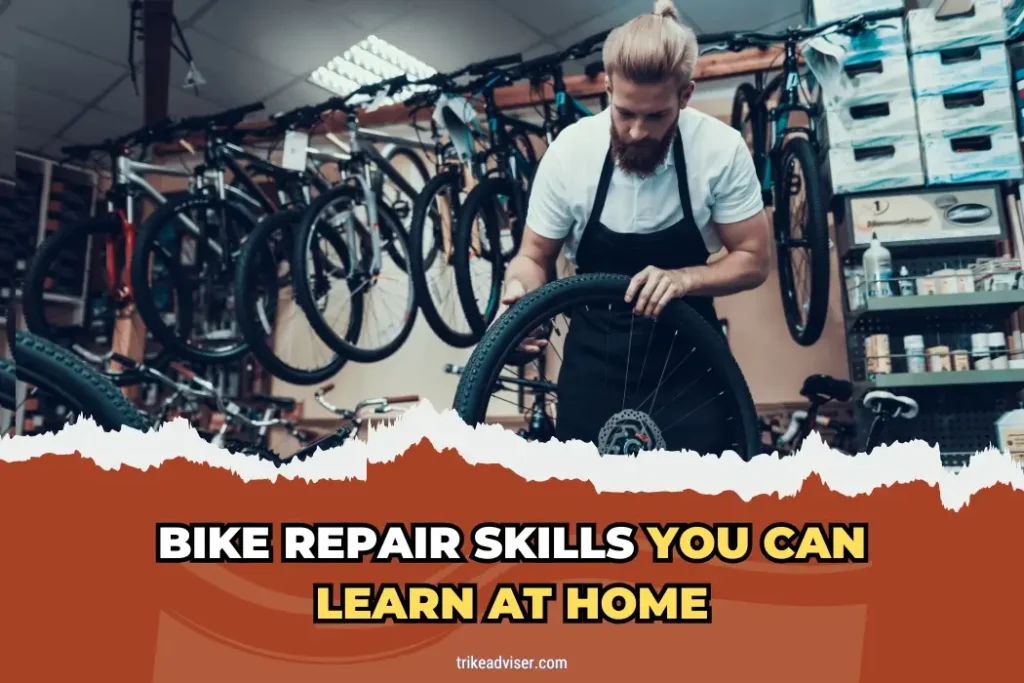“Bike Repair Skills You Can Learn at Home? Stranded with a flat in the middle of nowhere? Sounds familiar. Or that moment when your chain decides to give up as you pedal hard. We’ve all been there. Repair shops can feel distant when you least expect it.
Learning bike repair at home isn’t just smart; it’s essential. Think it’s too complicated? It’s not. With a few basic skills, you’ll tackle common issues confidently.
Wondering if it’s worth the effort? Consider this: can you afford unexpected walks home? Or the downtime waiting for professional repairs? If you’re nodding along, it’s time to empower yourself. Bike repair at home is your ticket to uninterrupted rides and newfound independence.”
Bike Repair Skills You Can Learn at Home
Installing a New Tire and Tube Replacement
Got a flat? No sweat. First, you’ll need to remove the wheel. Then, carefully replace the tube and tire. Ensure the tire sits evenly around the rim. This basic skill saves you from being stranded. Plus, it’s your first step towards self-reliance.
Patching a Bike Tube
Discover a puncture? Patching is simple and cost-effective. You’ll need a patch kit. Clean and sand the area around the puncture. Apply the patch firmly. This extends the life of your tubes, saving money over time.
Adjusting Brakes and Installing New Pads
Squeaky or unresponsive brakes? Adjusting them ensures safety. Loosen the brake cable, align the pads with the rim, and tighten. Replacing worn pads is just as crucial. It improves braking efficiency, essential for safe riding.
Cleaning and Lubricating Your Bike Chain
A dirty chain wears down components faster. Clean it with a degreaser. Then, lubricate it lightly. This maintenance task prolongs your bike’s lifespan and enhances performance.
Adjusting Seat Post, Saddle, and Handlebars
Comfort equals efficiency. Adjust the height and position for a perfect fit. It reduces the risk of injury and increases comfort on long rides.
Installing Racks and Trailers
Planning an adventure? Front and rear racks expand your bike’s carrying capacity. Attaching a trailer allows for even larger loads. These installations are game-changers for touring or grocery runs.
Tuning Front and Rear Derailleurs
Skipping gears? Adjusting your derailleurs ensures smooth shifting. This task might seem daunting but is manageable with patience and practice. It’s about fine-tuning for noise-free, crisp gear changes.
Installing and Removing Pedals
Whether upgrading or maintaining, changing pedals is straightforward. Remember, the left pedal unscrews clockwise. The right, counterclockwise. This knowledge is handy for pedal upgrades or travel disassembly.
Customizing Your Ride and Testing Skills

Upgrading Components: When and What to Upgrade
Feels like your ride could be smoother? Maybe it’s time for an upgrade. Start with what touches you: pedals, grips, and saddle. Then, consider the heart of your ride: cranks, chainrings, and wheels.
The right parts elevate performance, comfort, and style. It’s not just an upgrade; it’s a transformation. Match these to how you ride, where you ride. Suddenly, it’s not just a bike. It’s your bike.
Ergonomic Adjustments: Tailoring Your Bike to Fit You Perfectly
Ever felt off after a long ride? It’s likely your setup. Tailoring your bike can change everything. The stem, handlebar, seat — minor tweaks here mean major gains in comfort and efficiency.
It’s about aligning your bike to your body’s needs. Proper posture, less strain. The result? Longer rides, less pain. This customization isn’t just nice to have; it’s essential for every cyclist looking to go the distance.
Aesthetic Enhancements: Personalizing Your Bike
Your bike says something about you. Want to make it louder? Aesthetic tweaks are where it’s at. Think custom paint, vinyl wraps, unique accessories. Go bold with colors, or add subtle details that catch the eye.
It’s about standing out and expressing yourself. Each addition makes your bike more you. And when you ride, it’s not just about getting from A to B. It’s about enjoying every glance, every compliment, on your one-of-a-kind ride.
Tools and Workspace Setup

Creating a Home Bike Workshop: Essentials for a DIY Mechanic
Dream of turning wrenches in your own space? Let’s make it happen. First up, claim your corner. Basement or garage, it doesn’t matter. Just make it yours. A sturdy workbench? Non-negotiable. It’s the heart of your workshop, where everything happens. Make it waist high, with space to spare.
Now, about organization. Pegboard on the wall, friends. It’s a game-changer. Tools at the ready, no digging through drawers. Speaking of tools, start with the basics: cone wrenches, lockring remover, chain whip. Don’t forget a trusty floor pump and, yes, a bench-top vise. It’s not just about having the right tools. It’s about having them at arm’s reach.
And the bike stand? Essential. But hey, if money’s tight, get creative with hooks and rope. It’s about making it work, making it yours.
Tool Guide: Must-Haves for Every Cyclist
Every rider needs a kit. But what’s in it? Think of it as your bike’s first aid kit. The essentials: cone wrenches for those adjustments, a cassette lock ring remover, and a chain whip. Tire levers and a patch kit for those inevitable flats. And a chain breaker tool, because links do break.
Quality matters. Ever heard of Abbey Tools? They’re the gold standard. But remember, tools don’t need to break the bank. It’s about finding the right balance between quality and your wallet.
And let’s talk portability. Some tools should live in your garage, sure. But others? They belong with you, on the road or trail. Lastly, that bike stand we mentioned? Non-negotiable. It elevates bike maintenance, literally and figuratively. Even a simple DIY stand changes the game.
Learning Resources and Community

Books and Online Resources: Expanding Your Knowledge
Craving a deeper dive into cycling lore? The written word awaits. Whether it’s the tactile feel of pages or the instant access of online articles, there’s a world of knowledge at your fingertips. The League of American Bicyclists, for instance, isn’t just about advocacy. It’s a treasure trove of how-tos, safety tips, and cycling data. From maintenance deep dives to the ins and outs of bike commuting, these resources are gold mines for cyclists hungry for knowledge.
Key Points:
- Dive into books for comprehensive insights on bike mechanics and culture.
- Online platforms offer up-to-date advice and community wisdom.
Workshops and Classes: Learning from the Experts
Nothing beats the hands-on experience. Workshops and classes? They’re your direct line to cycling mastery. Places like Bike East Bay aren’t just teaching you to ride; they’re shaping savvy cyclists equipped for urban jungles and beyond. Think crash-avoidance skills, night riding nuances, and mechanic workshops. And it’s not just for solo riders. Families, kids, everyone’s welcome. With options from in-person to digital classrooms, there’s a fit for every schedule and learning style.
Key Points:
- In-person and online classes cover a wide range of topics.
- Learn practical skills directly from seasoned cyclists and mechanics.
Joining Cycling Communities: Sharing Tips and Experiences
Ever felt that buzz when cyclists share the road? That’s community. And it extends far beyond the asphalt. Joining groups like the League of American Bicyclists or local clubs opens doors to events, advocacy, and a network of peers. It’s about sharing road tales, tips, and support. Whether it’s planning group rides or volunteering for cycling initiatives, these communities are the backbone of the cycling world.
Key Points:
- Cycling communities are great for swapping tips and stories.
- They offer opportunities for social rides and contributing to cycling advocacy.
As an Amazon Associate, I earn from qualifying purchases, at no additional cost to you. Read Our Affiliate Disclosure.

